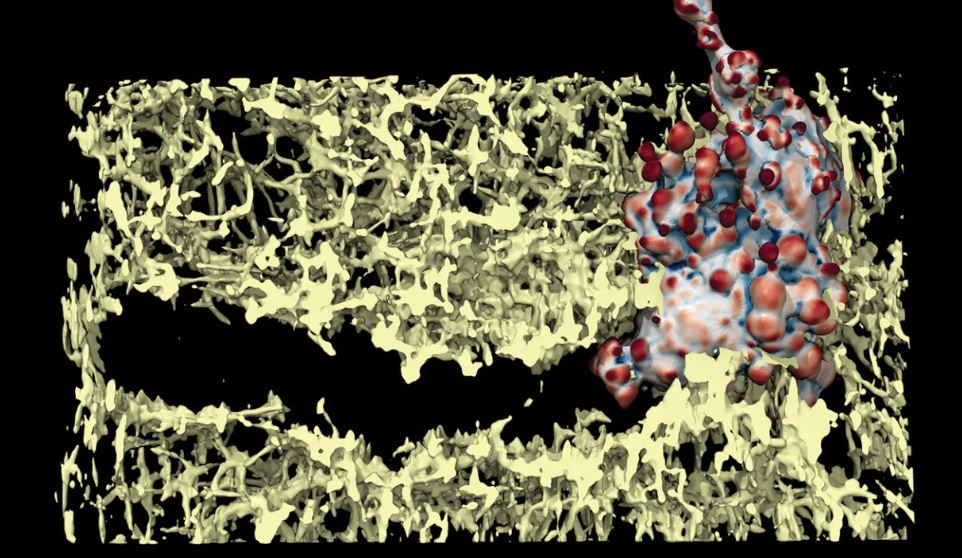A New Frontier in Cancer Cell Motility
In a groundbreaking discovery, researchers have unveiled a novel mechanism by which melanoma cells, the most aggressive form of skin cancer, navigate through bodily tissues. Contrary to the conventional understanding of cancer cell migration, which often involves the secretion of enzymes to break down the extracellular matrix, this research reveals that melanoma cells employ a mechanical “punching” motion to create tunnels through which they can traverse. This astonishing finding has profound implications for our understanding of cancer metastasis and may pave the way for innovative therapeutic interventions.
Blebs: The Cellular Fists of Melanoma
At the heart of this newfound mechanism lies a unique cellular structure known as a bleb. Blebs are blister-like protrusions of the cell membrane that form when the internal pressure of the cell exceeds the external pressure. Traditionally, blebs were thought to be a sign of cell stress or damage. However, this research demonstrates that melanoma cells actively utilize blebs as “fists” to punch their way through the dense network of collagen fibers that make up the extracellular matrix.
The process of bleb-mediated tunneling is a dynamic and cyclical one. Blebs extend and retract rhythmically, gradually degrading the collagen fibers and creating a tunnel through which the cell can migrate. This mechanical mode of movement allows melanoma cells to bypass the need for proteolytic enzymes, which are typically employed by other cancer cells to break down the extracellular matrix.
Microscopy Unveils the Tunneling Mechanism
The researchers employed a novel microscopy technique that allows for the observation of cells in a soft gel environment, mimicking the natural conditions of the extracellular matrix. This innovative approach enabled them to capture the intricate details of bleb-mediated tunneling in real-time.
Using this technique, the researchers observed that blebs extend and retract approximately every 20 seconds, gradually carving a path through the collagen fibers. The persistence of this cyclical process over hours ultimately leads to the formation of a tunnel large enough for the cell to traverse.
Molecular Signaling Guides Bleb Formation
The study also revealed that the formation of blebs is not random but rather guided by a complex network of molecular signals. Specifically, the researchers identified an increased concentration of phosphoinositide 3-kinase (PI3K), an enzyme involved in cell signaling, at the leading edge of the cell. This finding suggests that PI3K plays a crucial role in directing bleb formation towards the front of the cell, where they can most effectively engage with the extracellular matrix.
Furthermore, the researchers observed that molecular adhesions, akin to tiny feet, allow the cell to sense the tunnel surface and orient itself in the direction of travel. This feedback loop ensures that blebs are preferentially formed at the front of the cell, maximizing the efficiency of the tunneling process.
Implications for Cancer Research and Treatment
The discovery of bleb-mediated tunneling has significant implications for cancer research and treatment. It offers a new perspective on the mechanisms underlying cancer cell invasion and metastasis, potentially opening up novel avenues for therapeutic intervention.
By targeting the molecular pathways involved in bleb formation and signaling, researchers may be able to develop drugs that inhibit the ability of melanoma cells to tunnel through tissues. This could potentially slow down or even halt the spread of cancer throughout the body.
Key Findings:
| Aspect | Description | Significance |
|---|---|---|
| Bleb-Mediated Tunneling | Melanoma cells use blebs to mechanically tunnel through tissues. | Challenges conventional understanding of cancer cell migration. |
| Bleb Dynamics | Blebs extend and retract rhythmically, gradually degrading collagen fibers. | Reveals a novel mechanism for creating tunnels through the extracellular matrix. |
| Molecular Signaling | PI3K and molecular adhesions guide bleb formation and orientation. | Provides insights into the regulation of bleb-mediated tunneling. |
| Therapeutic Implications | Targeting bleb-related pathways could inhibit cancer cell invasion. | Opens up new avenues for developing anti-metastatic therapies. |
Summary:
The revelation that melanoma cells utilize blebs to mechanically tunnel through tissues marks a significant breakthrough in cancer research. This newfound understanding of cancer cell motility challenges existing paradigms and offers promising avenues for the development of novel therapeutic interventions. By deciphering the intricate mechanisms underlying bleb-mediated tunneling, scientists are one step closer to unraveling the complexities of cancer metastasis and ultimately finding new ways to combat this devastating disease.

Basant Kumar Sahoo is a seasoned writer with extensive experience in crafting tech-related articles, insightful editorials, and engaging sports content. With a deep understanding of technology trends, a knack for thought-provoking commentary, and a passion for sports, Basant brings a unique blend of expertise and creativity to his writing. His work is known for its clarity, depth, and ability to connect with readers across diverse topics.



